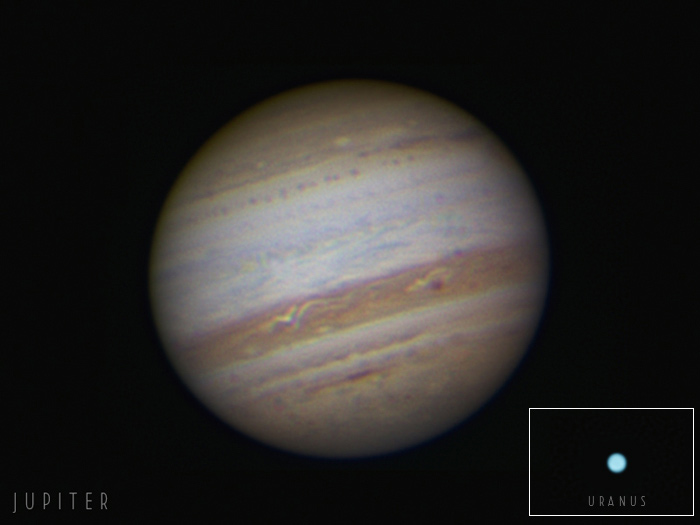Amazing Views of Jupiter and Uranus Thrill Skywatchers

The rare cosmic triple play of Jupiter, Uranus and the full moon this week is dazzling amateur astronomers with a bright night sky show.
"I never grow tired of viewing the planets," skywatcher Jimmy Eubanks told SPACE.com, adding that Jupiter is a longtime favorite. He photographed Jupiter and Uranus from his front lawn in Boiling Springs, S.C., on Monday (Sept. 20) during Jupiter's closest approach. [See Eubanks' view of Jupiter and Uranus]
Jupiter, Uranus and the nearly full Harvest Moon met in a rare cosmic lineup late yesterday (Sept. 22), just two days after Jupiter made its closest approach to Earth in nearly 50 years. Wednesday night's sky show also occurred on the equinox, marking the official start of the fall season in Earth's Northern Hemisphere, and spring in the south.
If you missed the sky show, don't despair. Jupiter will continue to be a bright skywatching target for several weeks, according to the skywatching website Spaceweather.com.
Through a small telescope, the brilliant bands of color from the turbulent atmosphere of Jupiter were unmistakable, Eubanks said. At the time, Jupiter was 3.95 astronomical units, or AU, from Earth. One AU is the average distance between Earth and the sun, about 93 million miles (150 million km).
"It's quite a surreal experience to view an object that is so far away and know that you are watching weather on another planet," Eubanks said. He used a Meade 8-inch SCT telescope? to capture his photos.
In Arizona, amateur astronomers were also treated to clear skies, serving as the perfect stage for Jupiter and Uranus.
Get the Space.com Newsletter
Breaking space news, the latest updates on rocket launches, skywatching events and more!
Photographer Jin Lu in Tempe did not expect a good view of the planets. The telescope he and his friends were modifying with a new camera wasn't ready yet. But he pointed his Nikon D90 camera with an 18-105 mm lens to see what he could see on Sept. 19.
The result, he said, was amazing. [See Lu's photo of Jupiter and Uranus]
"Jupiter, its moons and Uranus were just there," Lu said, adding that the weather was perfect for viewing. "The fourth moon, Europa, was too close to Jupiter and could not be seen."
Lu also snapped this long-exposure photo of Jupiter, which shows the planet's movement across the sky in front of a sea of stars.
In the Phoenix suburb of Gilbert, Ariz., skywatcher Pat Jameson did not have a telescope, but still made a point to look for Jupiter after reading about its close approach on SPACE.com.?
"I had never pointed binoculars at any celestial body other than the moon ? and I was stunned to see three pinpoints in a straight line through the middle of Jupiter," Jameson said, adding that it was clear they were Jupiter's moons. "Amazing, with all the ambient light of the city, I could still see them. How cool is that?"
- Photos: Jupiter and Its Many Moons
- Telescopes For Beginners
- 'Super' Harvest Moon Marks Earth's Changing Seasons
Join our Space Forums to keep talking space on the latest missions, night sky and more! And if you have a news tip, correction or comment, let us know at: community@space.com.

Tariq is the Editor-in-Chief of Space.com and joined the team in 2001, first as an intern and staff writer, and later as an editor. He covers human spaceflight, exploration and space science, as well as skywatching and entertainment. He became Space.com's Managing Editor in 2009 and Editor-in-Chief in 2019. Before joining Space.com, Tariq was a staff reporter for The Los Angeles Times covering education and city beats in La Habra, Fullerton and Huntington Beach. In October 2022, Tariq received the Harry Kolcum Award for excellence in space reporting from the National Space Club Florida Committee. He is also an Eagle Scout (yes, he has the Space Exploration merit badge) and went to Space Camp four times as a kid and a fifth time as an adult. He has journalism degrees from the University of Southern California and New York University. You can find Tariq at Space.com and as the co-host to the This Week In Space podcast with space historian Rod Pyle on the TWiT network. To see his latest project, you can follow Tariq on Twitter @tariqjmalik.









